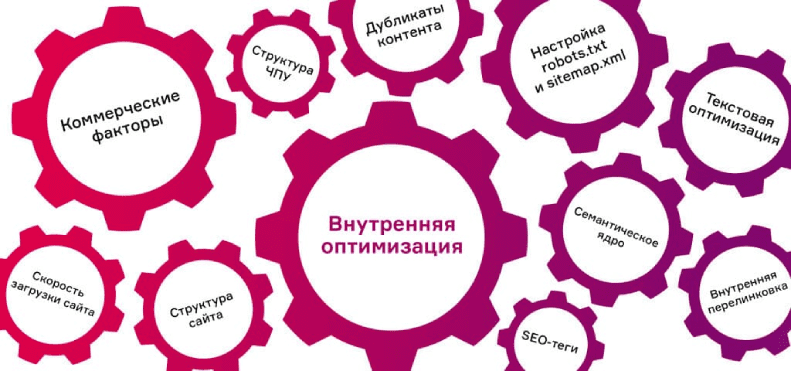
Search engine optimization of a site is a set of works aimed at meeting all the requirements of search engines in order to obtain top positions in the ranking of an Internet resource in search engines.
Search engine optimization sites can be roughly divided into internal and external. The internal optimization method is aimed at a set of technical internal work within the site, such as work with navigation, content and usability. Such a method as external optimization, in turn, improves the visibility of the site by obtaining high-quality inbound links (link mass).
Both internal and external methods of search engine optimization are very important and only complementing each other can bring the desired result in ranking your keywords in the top search engines. For example, if you build up link mass and increase the flow of traffic to your web resource, but do not carry out high-quality internal optimization for navigation on the site, page load speed, fixing low-quality over-optimized content on the site, this will scare away the users and, ultimately, the traffic that comes to the site will not give any desired result.

Optimization of the web resource’s pages. The first thing to do when optimizing your site for search engine optimization is to conduct a full page check. This includes such important indicators for search engines as: writing the meta tags, the H1-H6 headings, human-readable url of pages (CNC), writing high-quality SEO content, correct title and description from the point of view of search engines (title - 58 characters, description - 137 characters) and also make sure that the H1 headings do not duplicate with the title. The subtleties of the page optimization method include adding the main keyword with a direct entry into the title and write it in the page's CNC.
The basic principle of search engines is "do it for the people, not for the search engines" and it is easy to agree with this, if you attract traffic to your site with obviously low-quality content or other poorly optimized factor, then there is a high probability that soon you fall out of the top of the promotion. Here, much attention should be paid to the content of the site. It should be adjusted if you have outdated and low-quality information on the site, edit all non-original content, check the text for readability, style, keywords and text wateriness. Also worth mentioning is page nesting. Practice shows that the fewer clicks the user makes to the final goal, the better. Therefore, when developing a site, try to limit yourself with a three-level nesting of pages.
Optimizing images. Quite a weighty method of site search engine optimization, which increases the page loading speed. In most cases, it is the pictures that weigh more than all other elements of the page and slow down the speed of its loading. Change, if possible, formats that can significantly reduce the weight of the picture. For example, the .webp format can be such a solution. Use vector images whenever possible. In addition to reducing the weight of the image, you can scale the image to the required size, limit the color gamut and apply the delto coding. Another plus will be the writing of meta-tags of images, meta-alt and the title. This will help the search robots to identify and index it faster when scanning.
Internal linking. Means placing links to a page in the text of another page. The goals of this optimization method can be different. For example, competent linking in the text by keywords can send the user to another page in order to find the missing information for them, thereby increasing the behavioral ranking factor. This method of search engine optimization of a site also helps in the distribution of the weight between pages, which increases its authority within the site and is an important factor in getting into the top search engines.
Commercial factors. An important factor in website promotion that search robots take into account when ranking for such commercial queries as: price, order, buy, etc. These factors include product and service pages, contact details, order and callback forms, chatbots, product filters, photos and reviews.
In order for search engines to take this factor into account, it is necessary to constantly work to improve your Internet resource (add new photos and videos, add user-friendly payment and delivery methods). All this is done to ensure that the users stay as long as possible and order on the site. In turn, the commercial factor can improve the behavioral factors of the site.
Behavioral factors. It is important not only for search engines, but also for their own analysis. It can show how users behave on the site, how convenient and interesting it is for them to be on it. The PF analysis uses such statistical data from Google Analytics as: the number of user sessions, bounce rates, the number of pages viewed within one session, the average session duration. It's also worth looking at the user behavior map provided by Google Analytics. SEO website promotion largely depends on behavioral indicators and can play a colossal role in its promotion.
Social factors. This method of website promotion is to increase the visibility of a web resource using social networks. Create your own group or business page. Firstly, it will give you an increase in brand awareness and an increase in traffic, and secondly, according to statistics, sites that are in the top results in search engines have a presence in search networks. This is a fairly powerful ranking factor that is taken into account by Google and Yandex.
Technical optimization. To begin with, it is worth saying that the correct technical optimization helps search robots to quickly and without errors scan your Internet resource. Considering that search engines almost always display only technically optimized sites in the top of the SERPs, it is simply necessary to correct all the mistakes. Yandex.Webmaster and Google Search Console services can help with this difficult matter. For example, here you can see whether there are broken pages on the site or whether the web resource is optimized for mobile devices, as well as many other parameters.
You can also use third-party programs that do a good job of analyzing the search for duplicates of the title, description and H1 meta tags. The Screaming Frog program can become an assistant.
Page loading speed. A factor affecting the bounce rates. You can analyze page loading speed using Google's PageSpeed Insights service.
The robots.txt file. This is a text file, the task of which is to tell search engines which pages should be indexed and which should not. It also contains redirects.

With the arrival of the Minusinsk and Penguin algorithms, the filters of the link factor of ranking in the search engines Yandex and Google, have significantly increased. Therefore, when promoting a site using links, it is necessary to take into account a number of factors affecting the fact that search engines take these links into account.
A 2020 research shows that the number of unique links, donor domains and unique pages linking to the acceptor domain have almost the same impact on website promotion. Therefore, it is better to place several links on different pages of a good donor than the same number on several weak ones.
The presence of the exact occurrence of the key in the anchor of the link becomes optional. Try to use synonyms of your keywords in the link anchor and surround your link with content that is relevant to the path the link leads to.
Donor domains. Try to choose quality donors. High-quality domains include domains of your topic, which are referenced by authoritative sites of similar topics and in your region.
Crowd marketing. This is a method of posting links using replies on forums, blogs, product comments, where the text mentions the name of the company in the form of an anchor to which the link leads. Such links are not a priority, as they are small, but they are useful because in this way you can leave a significant number of references to your site, thereby increasing the brand's visibility on the Internet. Also, search engines consider this method of placing links to be natural, and therefore useful.
When placing text with a link, you must take into account the type of site. On forums, share your impressions, provoke discussion, on blogs write texts in the form of personal opinions and reflections. Also work out the text in the comments, which should be highlighted by valuable information related to the topic of the material.
Primary source. Make sure that your information is original and not copied from other sites. Unique text around the link will increase its value.
Press releases. Constantly post information about your site, business news, announcements. This will serve as a green signal to search engines and let them know that the site is alive and actively working to improve and increase the user experience.
Outreach. Paid method of posting links to large and reputable sources. Although search engines have a negative attitude towards outreach, such links are very useful and can bring a web resource to the top in a few days. When placing such links, try to make sure that the link placed in the text is natural and does not arouse suspicion for search engines.
Leaders in the IT market |
| 14+ years of experience and innovative solutions to help your business stand out and grow. |
Inspiring portfolio |
| 150+ successful projects: from sleek landing pages to complex corporate systems. |
Team of experts |
| 51+ professionals who bring your ideas to life with maximum efficiency. |

| NOTORIUM TRADEMARK AWARDS |
| Notorium Trophy 2017, Notorium Gold Medal 2018, Notorium Gold Medal 2019 |

| TRADE MARK OF THE YEAR |
| Gold Medal 2016, Gold Medal 2017, Gold Medal 2018, Gold Medal 2019 |

| THE BEST EMPLOYER OF THE YEAR |
| According to the annual Survey conducted by AXA Management Consulting - 2017, 2018, 2019 |